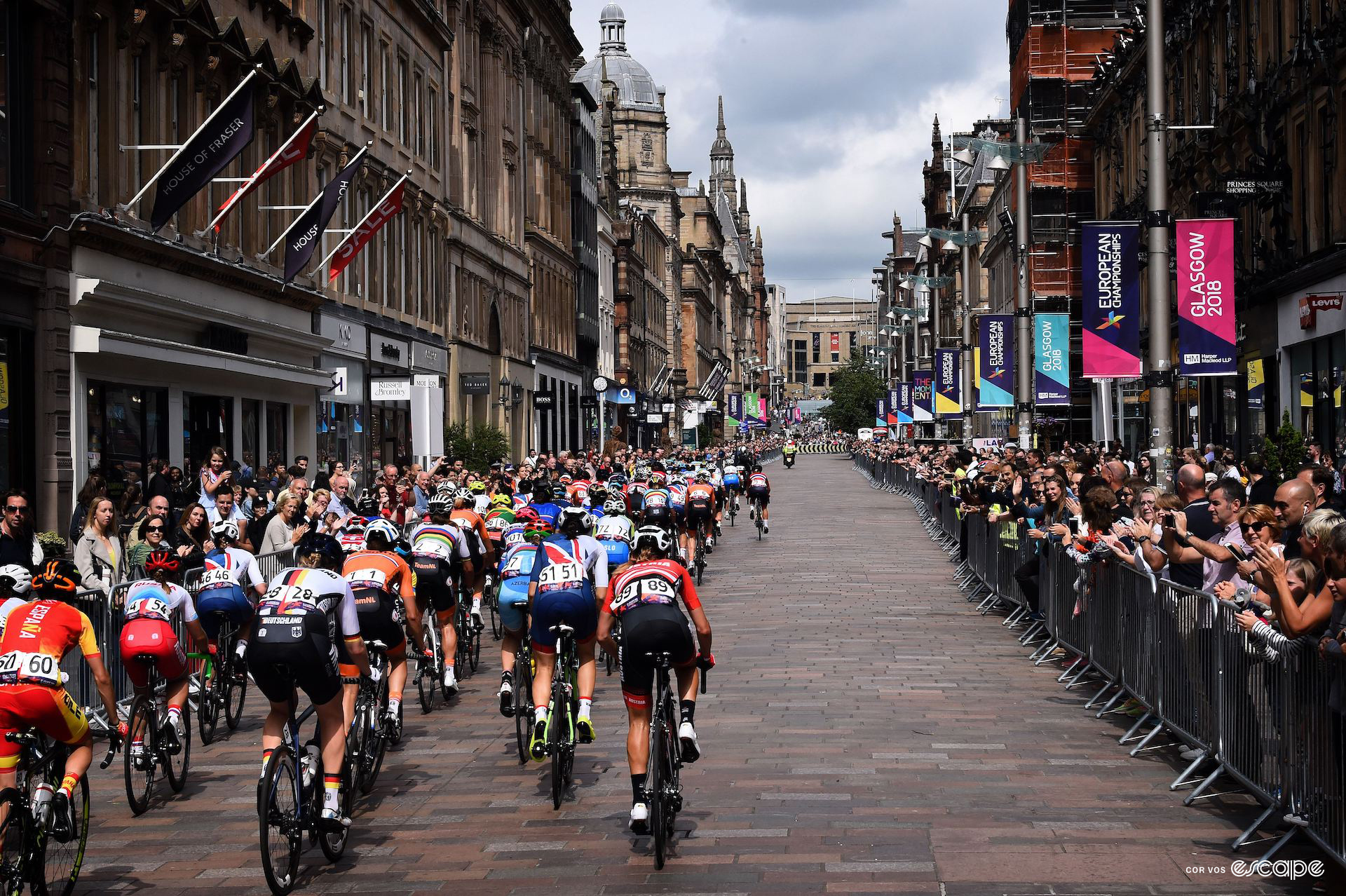This preview was written with the help of Escape Collective members Kerry Docherty, Murray Ferguson, Andy Gerrie, James Kinsella, Michael Main, Jack Wright.
A lot has been said about the upcoming World Championship road races, most of it, let’s face it, weather related. But besides the stereotypical forecasting – which looks quite likely to be fulfilled this weekend – there’s also been a lot of talk about how challenging the courses look, specifically the city-centre laps in Glasgow.
Scotland is known for its hills and rugged landscape, much of that extending into the towns and cities, but just how tough and ‘attritional’ can we expect it to be? We asked our community of Escape Collective members if any Edinburgh/Glasgow/Stirling locals had experience with the roads being used for the World Championships, and the response was enthusiastic.
So here’s a local, in-the-know preview of the road and time trial routes, split into sections that cover the two disciplines, the different routes into Glasgow, and the crucial finishing laps where the road races are set to be decided.
The routes leading into Glasgow


Both elite races and the men’s U23 road race start outside Glasgow, with the elite men rolling out from the historic capital of Edinburgh, and the bonnie banks of Loch Lomond offering a picturesque start for elite women and the under-23 ranks.
Loch Lomond
Besides some dodgy road surfaces through a couple of the villages, there’s not much to say about the roll out from Loch Lomond, except that there’ll be time to enjoy the scenery as the route skirts the edge of the Loch Lomond & The Trossachs National Park – it’s way too soon to accurately predict, but it looks like the second weekend of the World Championships may be considerably brighter and dryer than the first.
The two routes meet at Fintry in time to take on Crow Road, but before we get to the most well-known climb on the course, we’ll divert to Edinburgh, the starting point for the elite men’s race.
Edinburgh and Fife
Depending who you ask, the fact that the elite men set off from in Edinburgh at the start of the internationally renowned Edinburgh festival season is either a stroke of genius or a significant error in judgment; there’ll be people everywhere, so even with its relatively prompt start for a Sunday morning, there should be curious crowds lining the roads in the city centre.
That said, as members James and Murray point out, the start will be interesting to look at but ultimately inconsequential. In the neutral depart, the peloton rides from Holyrood Palace, up the Royal Mile and down through New Town on a fairly uncomfortable cobbled descent (I’ve been down it once in my life and that was enough), before kilometre zero on the edge of Stockbridge. It’s here that the roads get wider and straighter, the surface “better” (than cobbles at least), and speed will quickly pick up on the way to the Queensferry crossing.
The next obstacle is a bridge across the Firth of Forth, but before you get excited about the possibilities of crosswinds adding some (very) early excitement, they’re using the newest bridge of the three that has not been open to cyclists since before it opened, and which has specially designed sides to limit the often-stiff winds that whisk up the Forth. After the crossing, the roads are predominantly uninteresting for a while and member Michael points out that the breakaway will be visible for a long time.
There’s a lot we could say about some of the towns and villages that the routes wind through, often literally – for instance, the pinch point through Culross (pronounced ‘coo-ris’) and the steep climb out of Denny into Fankerton – but given the length of the race, any sharp corners, short cobbled stretches and sharp ramps are unlikely to create much action, and none of them can really be likened to what you might find at the Spring Classics.
Michael says, “treat this part like the boring bit of Milan-San Remo,” i.e. no need to cancel your Sunday morning ride.
Crow Road
Then, eventually, we get to Crow Road, which comes shortly after the routes from Edinburgh and Loch Lomond meet.
The consensus from our members is that it’s a shame this climb doesn’t come later in the routes; the elite women and U23 men still have 120+ km to race after the summit, and any early breakaway in the men’s race will have 170 km to go after cresting the climb.
Though it’s most likely a big-ring climb for the pros (it’s not even five kilometres long), the steep ramp near the foot and the potentially windswept plateau over the top could combine to create a launchpad for opportunists, if only to bridge to the tiring early break, or indeed to set one up in the women’s or U23 races given it comes in the first 30 km. But the chance of any real drama here is slim.
The real challenge our local riders have expressed is the surface of the roads in this area, including potholes so big they might be classed as road furniture at this point, though Murray assures us that the the surface is now much smoother, at least in the run-in to Crow Road from the wind tunnel that is Carron Valley.
The descent off the top is fast and not technical, but for a corner at the bottom into Lennoxtown – one of our members says he once reached 90km/h screaming down there – then it’s a straightforward rolling ride into Glasgow, one last chance for breath before the attritional finishing laps.
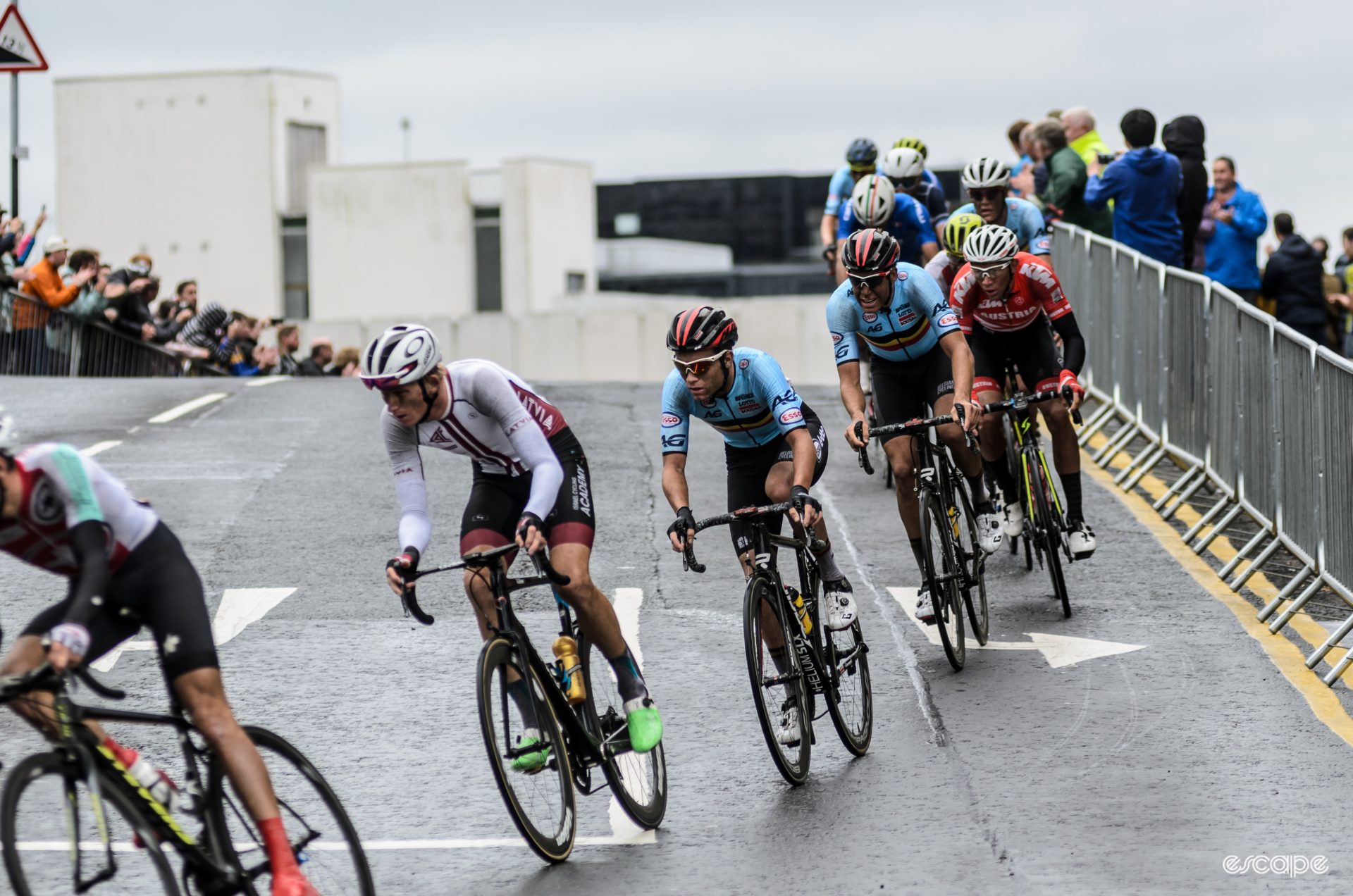
Glasgow circuit
All categories from junior to elite are taking on a varying number of laps in Glasgow, as is the Team Time Trial Mixed Relay (though it uses a slightly extended version of the circuit). And while, again, it’s no Spring Classic, it’s far from easy and frankly, though we’re prepared to be proven wrong, most of the members and yours truly are not expecting the sprinters to have their day.
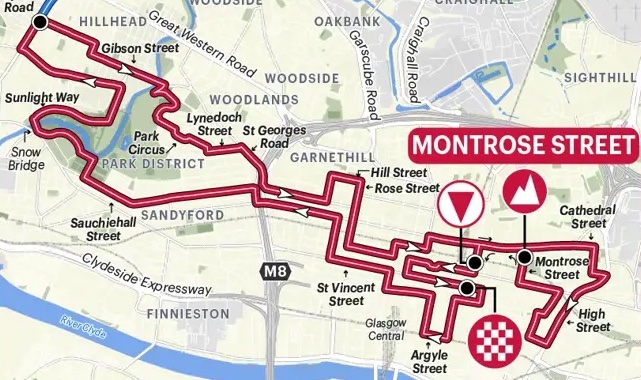
Member Jack sees the circuit, which James describes as a “deluxe criterium,” as a route of two halves: “the eastern half with the finish line where it’s all 90-degree bends, up and down, punchy climbs, but there’s less road furniture; and the western half where there are some faster sections, slightly less hilly, but the road width is constantly changing.” Andy adds to this, indicating that the only real respite comes on the Sauchiehall Street approach to Kelvingrove Park, and even then, the flat or slightly downhill stretch is not long. The real crunch will come in the latter half of the circuit.
This may come as a surprise, but Glasgow has become quite popular with Hollywood as a substitute for Manhattan thanks to its grid-like urban centre. Most notable was its recent use as Gotham City in Matt Reeves’ ‘The Batman’ starring Robert Pattinson and Zoë Kravitz. Add to the repetitive corners the steepness of some of the climbs that come with little to no warning – the most violent being Montrose Street, Great George Street and Scott Street – and you’ve got the base ingredients for a blockbuster finale. It also means that though it may be hard to get away, even a gap of a few seconds will mean any escapees will quickly disappear from view, and the stop-start nature will make it hard to close.

Member Andy is a Glasgow resident, so was on the ground for the 2013 British Nationals, 2014 Commonwealth Games, and 2018 European Championships, and given past experience and a walk-through of key parts of the course this week, he expects an attritional race where positioning will be key, especially in the eastern half, so the start and end of each lap.
He, Kerry and James are all intrigued by the route’s cutting through Kelvingrove Park in the West End, roughly mid-lap, which has required removal of a gate at the pedestrian entrance. The path/route takes the peloton through a hairpin turn and straight up the hill to Park Circus, so again, good positioning will be vital. Jack notes that before the route gets to the park, there’s a potentially treacherous pinch point where the race will be funnelled from two lanes to one, with kerbs on either side leaving no room for error, so the bunch could be strung out before it reaches the Kelvingrove challenge.
In contrast to past uses of the city centre, the final kilometre is as technical as the rest of the circuit, with three right-angle bends and a chicane, the last left-hander coming just inside 500 metres from the line – Kerry notes that a traffic island on the last corner has been removed.

Speaking of road furniture, it’s worth a quick mention of some of the surfaces too. Most of the course takes place on fairly predictable patchy British tarmac, but for Kelvingrove Park, Gordon Street, Buchanan Street, Rottenrow and Lynedoch Street. Gordon and Buchanan Street’s smooth pedestrian flagstones in particular could be treacherous if wet, though Andy notes that there were no issues that he can remember in past races. Rottenrow and Lynedoch Street are laid with ‘cobblestones’ that are not significant in cycling terms – it’s much closer to smooth patio paving – but again, could be slippery when wet.
Weather will have an impact on the routes, regardless of how many circuits and where the races are coming from (Loch Lomond or Edinburgh). It looks very likely that the elite men will race in grotty conditions, and at the very least the roads will be damp from several days of torrential rain. i.e. very similar to the men’s European Championships in 2018, won by a grit-covered Matteo Trentin (Italy) ahead of Mathieu van der Poel (Netherlands) and Wout van Aert (Belgium) having formed part of a nine-man escape. The women got away with it that year, Marta Bastianelli (Italy) winning the sprint with a sharp shadow under her bike.
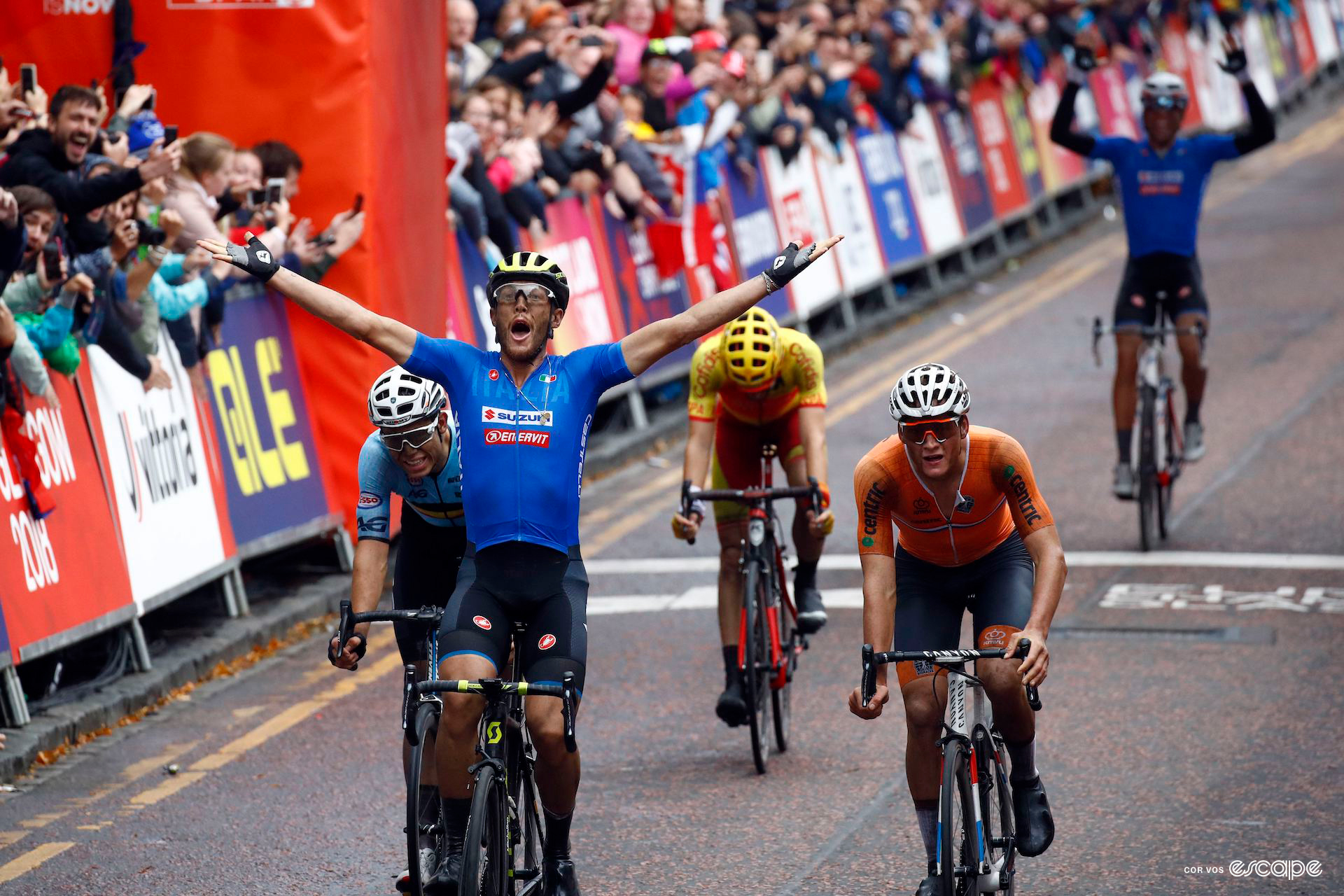
So, what are we looking out for on the Glasgow laps?
- Great George Street about 8km from the finish. Steep corner leads into 325-metre long climb at 7.6%, max 11%
- Kelvingrove Park climb, roughly halfway through the lap. Approx 400m long, average 6%
- Left turn onto Scott Street in last 6km. Sadly only about 150m long but averaging 13% with max 23% in the lower half
- Montrose Street 1.5km from finish. Only 160m long, average 13.5%, max 15%, followed by a short descent then flat finish – the organisers have flagged this as a key point, for very good reason
- Technical final kilometre into George Square
Time trial routes
In comparison to the Glasgow circuit, the Stirling time trial route is far easier to assess. Starting and finishing in historic Stirling itself, each route takes the riders westward towards the distant verdant hills of the Loch Lomond & The Trossachs National Park, but despite being surrounded by hills, it’s a fairly flat route, for the most part. It would be hard to put it better than James: “the TT loop is really just a big boys’ play ground, so one for the real testers.”
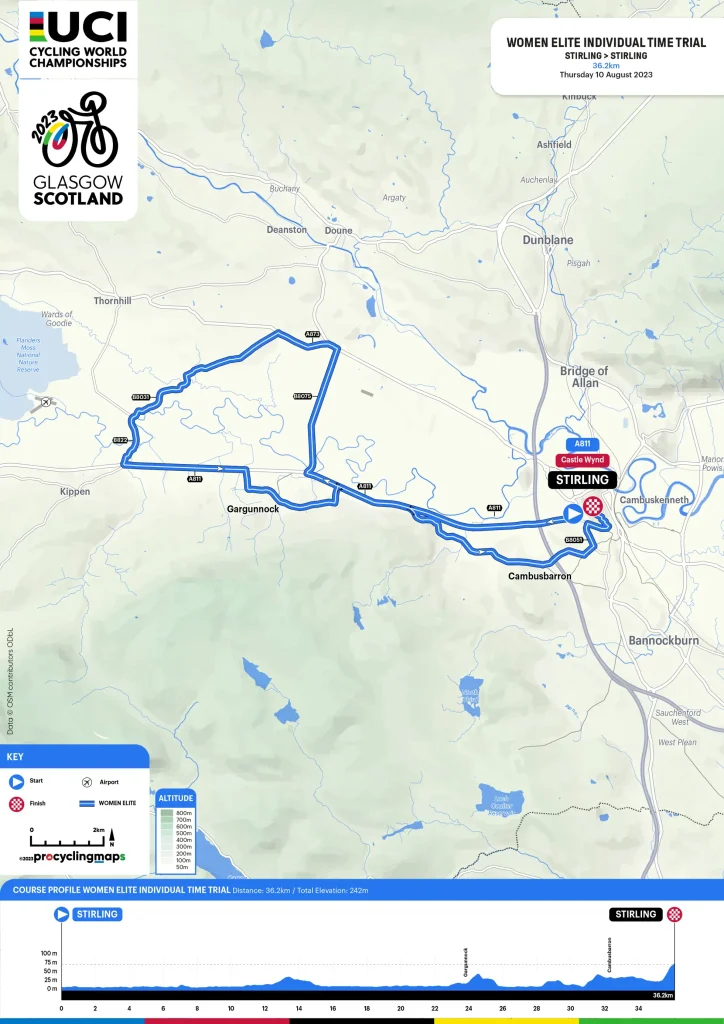

All the routes set out from the edge of town and along Dumbarton Road, where Murray warns that there is often a block headwind. It’s pretty much pan-flat until the first time check, and then the first of the climbs begin – the additional section for the elite men is particularly lumpy, so time lost in the first power section isn’t the end of the world, but it will make for a very difficult time trial, especially those expecting to struggle more on the gradients to come in the back end.
Coming five kilometres from the line, the climb through Cambusbarron will hurt the legs and lungs, but it’s the finishing climb to the castle that’s most intriguing. It’s apparently the longest and steepest in the area, not to mention picturesque given what’s waiting at the top, and though it amounts to just a few hundred metres, it’s steep and cobbled all the way up – it’s also lined with pubs which may provide a particularly jovial atmosphere.
It’s unlikely to ruin the day of any of the purists, but it may level the playing field just a smidge, giving the punchier specialists something to hope for. Every second counts.
Predictions
The outcome of all the races will very likely depend on the weather. As it stands, and with the usual caveats regarding weather forecast reliability, it looks like the elite men’s road race will have changeable conditions with the chance of rain later in the day, but regardless of what might fall on them during the race, the roads will already be well-saturated after this week’s relentless downpours. It’s due to brighten up a bit next week, though, so the women and U23 road racers, and time trialists, may have one less thing to worry about.
The consensus from our contributors is that the drama will be lacking until the road races reach Glasgow, where those with numbers at their disposal will make the race as tough as possible, before finally a small group gets away to wrestle over the rainbow bands between them. There were also several mentions of Remco Evenepoel, who won solo last year and is no slouch on hilly parcours, likewise Lotte Kopecky who not only is in superb form but has reportedly been putting herself to the test in technical junior criteriums back home in Belgium.
Either that or we’re all hopelessly wrong and the pros will make Glasgow look flat, keeping things under control for an aggressive bunch sprint. But I really really doubt it …
What did you think of this story?
